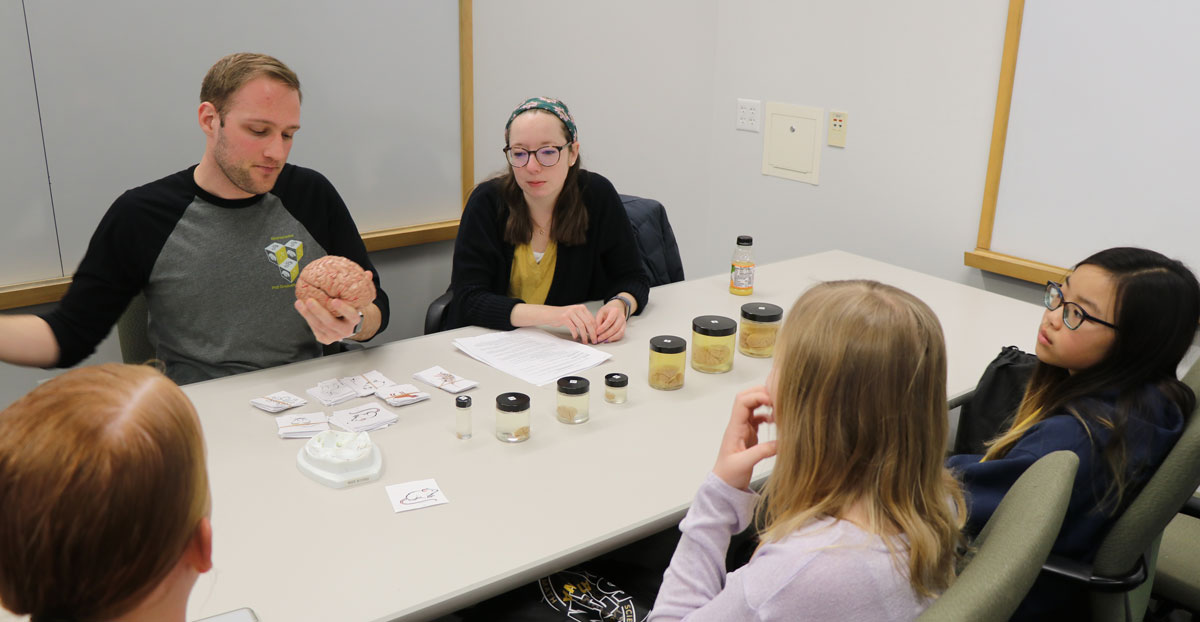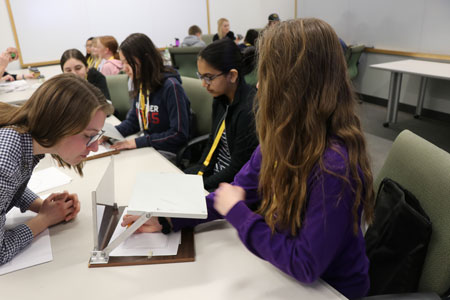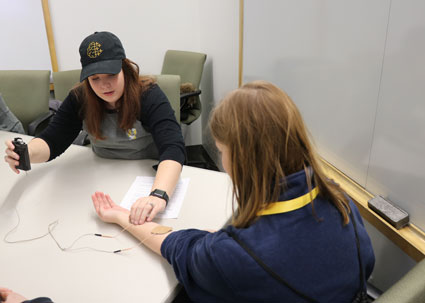
Emma Thornburg didn’t find her passion for asking critical questions and applying the answers to actual diseases until college.
As a first-year PhD student in neuroscience at the University of Iowa, Thornburg is spending her “free time” volunteering in outreach activities to help young scholars develop a passion for science much earlier in their academic careers.
“I really wish I had found my passion earlier. Doing outreach events allows me to help people find that passion,” Thornburg says. “Students should find what they are curious about and what makes them ask questions.”

Thornburg, Parker Abbott, Amanda Bullert, Bess Glickman, Camille Hanes, and Tim Skog – all doctoral students in the Neuroscience Graduate Program – shared their love for science with students in grades 6-8 at Kids Go STEM on March 7 at the Medical Education and Research Facility on the UI medical campus.
Graduate and professional students led participants in wide variety of hands-on medical simulations and science experiences in such areas as emergency medicine, orthopedics, and gross anatomy. This event is one of around 160 STEM education programs put on by University of Iowa Health Care annually for an average of 17,500 students in grades K-12.
“The STEM industry is growing faster than any other, so we need people to fill those positions in the future,” says Emily Strattan, a STEM education specialist for UI Health Care. “We need to have people interested in those careers, and it starts with sparking an interest in students at an early age.”
The neuroscience graduate students conducted activities that shed light on the nervous system and how it affects one’s behavior. Participants rotated through four 30-minute stations: a tracing activity focused on motor memory, a study of actual animal brains to understand different brain functions, a TENS unit that helps stimulate your nerves to fight depression and chronic pain, and an eye-hand coordination activity involving throwing and catching a ball while wearing goggles.
For Skog and his colleagues, serving as event volunteers plays a key role in their development as doctoral students.
“When you get into higher education, it’s very easy to lose sight of the forest and focus on the trees,” says Skog, a third-year graduate student. “This is a good chance for us to get a wider perspective again and not get stuck in the trees. Most people don’t fully understand everything we do. We need to explain it to people in a way that they understand it and appreciate it.”
These doctoral students take a walk down memory lane when sharing their appreciation for neuroscience with the young scholars.
“Sometimes we get into our lab experiments and forget about other part of it; the learning about the science and what it was like when we first started,” Skog says. “We really enjoy doing this because we get to go back and remember what it was like when we were first exposed to science and how cool it was. It reminds us how cool everything we do every day is.”

Hanes understands the importance of exposing these middle school students to STEM education at this age.
“I have always been interested the brain, but I didn’t learn about it in middle school and high school, so I would have to go to the library and check out books,” says Hanes, a second-year graduate student. “That’s why I think it’s important to have these events for kids, because they don’t learn about it in school. If they do hear about the brain, it’s in pop science news, which isn’t always correct. It’s good to have these kids do hands-on activities, so they can better understand the brain.”
Neuroscience doctoral students also volunteer in other annual events like Girls Go STEM and the Iowa Brain Bee, a neuroscience competition for high school students. Neuroscience Program administrators don’t require their graduate students to attend these events, however, it only takes a few emails to fill out the lineup.
"The importance of outreach activities is impossible to overrate, and graduate students in our Neuroscience Program are incredibly valuable ambassadors for communicating the excitement of a career in science to young people,” says Dan Tranel, professor of neurology and psychology and director of the Neuroscience Graduate Program. “The graduate students also find these outreach activities extremely valuable, as they learn how to share their passion for science in ways that young people can relate to."
After the Kids Go STEM event, the doctoral students had some advice for the middle schoolers who are beginning to make their way down the academic road to college.
Thornburg encourages them to not be afraid to experience failure.
“I got a C-minus in my first biology class in college and I’m getting a PhD in neuroscience,” Thornburg says. “If you find a topic you’re passionate about, even if it’s challenging, it will keep you going on the hard days. Failure is so common in science that it’s easy to let it affect you in a negative way.”
Skog agrees that it’s important to find a research topic you love.
“You can get a PhD in just about anything,” Skog says. “Knowing about a lot of different things can help inform you about whatever you end up doing. Learn the most you can about anything that excites you.”